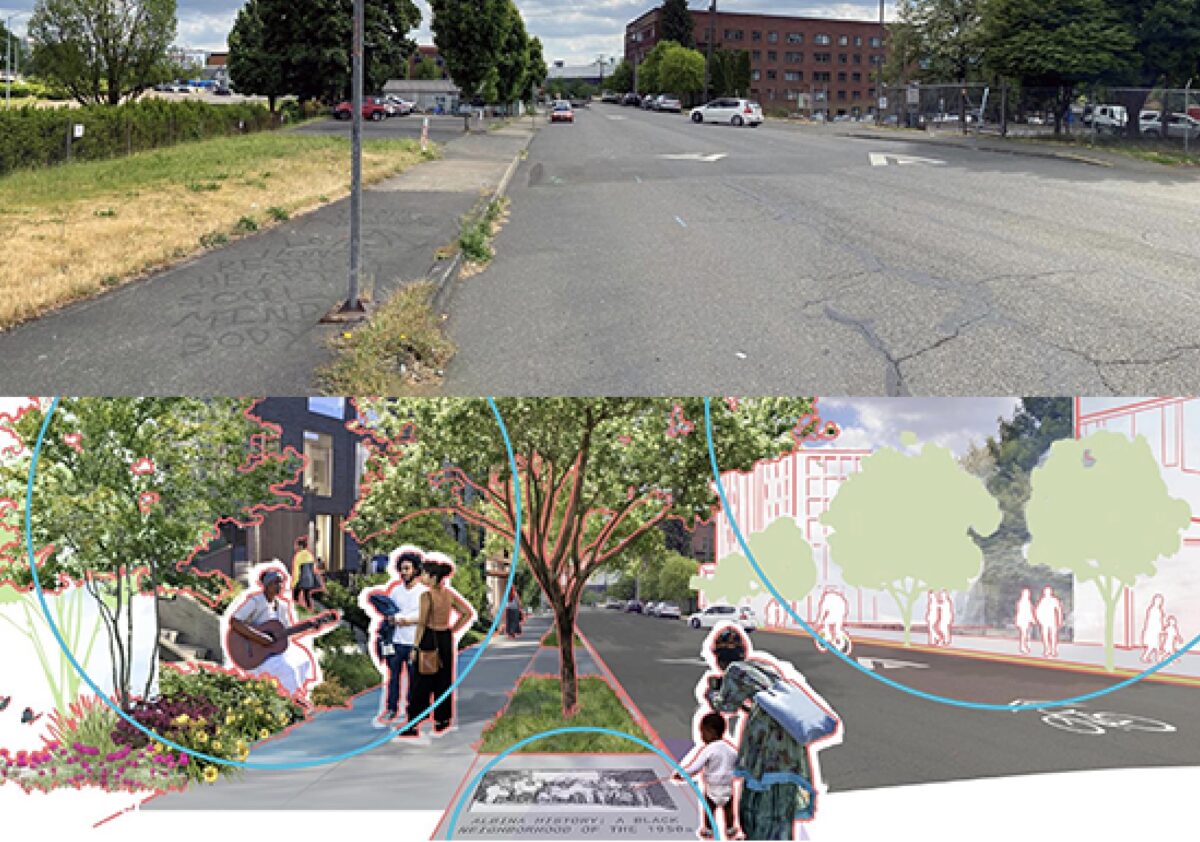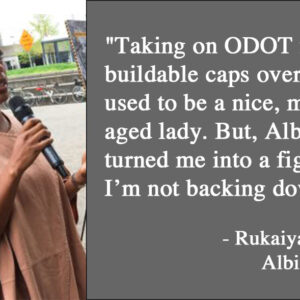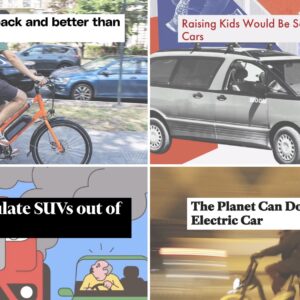
“A lack of transparency in ODOT’s cost assumptions has continued to hamper partner decision-making ability.”
— Letter signed by leaders of City of Portland, Metro, and Multonomah County
The honeymoon is already over.
After Oregon Governor Kate Brown stepped in to lay out a major compromise on the controversial I-5 Rose Quarter project earlier this week, it appeared as though the Oregon Department of Transportation could breathe a little easier.
But negotiations and demands from key partners have already begun in earnest — making it clear that while chances of stopping the project have plummeted, there remain major hurdles for ODOT to clear before it breaks ground.
Widening I-5 near the Moda Center is the state’s top transportation priority and ODOT has dreamt about it for many years. They’ve also faced stiff opposition to the plan from nearly every corner. Anti-freeway activists don’t want any expansion (“auxiliary lanes” or otherwise), Albina neighborhood activists want the project to restore the neighborhood that ODOT (and others) decimated with development decades ago, and elected officials are scared to seem overly supportive of such a complicated and controversial plan that comes with (at least) an $800 million price tag.
That’s why Governor Brown’s support for the project and consensus-building, compromise plan for the freeway covers announced on Tuesday was such a big deal. It gave ODOT life and much-needed momentum to push the project forward. A perception of inevitability is imperative for these mega-projects.
However, 48 hours after this gentle nudge from the Governor, the project still faces major hurdles and the support it needs from electeds and key community partners could still prove elusive.
Advertisement
On Thursday, Portland Bureau of Transportation Commissioner Jo Ann Hardesty, Multnomah County Commissioner Jessica Vega Pederson, and Metro President Lynn Peterson sent a three-page letter (PDF) to Governor Brown outlining their demands. And last night on Twitter, Albina Vision Trust Board Member Rukaiyah Adams made it clear that while her group is now willing to return to ODOT’s table, not everything is hunky-dory.
“This is not the finish line, it is not even the starting line.”
— Rukaiyah Adams, Albina Vision Trust Board Member, on Twitter last night
In their letter, the leaders of the county, city and Metro expressed gratitude to the Governor for forging a consensus on the highway cover plans that they said, “Creates a shift from a freeway space, to a restored neighborhood place.” But it said ODOT would enjoy their support only under certain conditions. They’ve set out a list of technical considerations for the Hybrid 3 highway cover design endorsed by the Governor’s agreement.
They want promises from ODOT to shift the southbound I-5 off-ramp further north to reduce impacts of highway traffic on streets, and they want the I-5 centerline to be moved east and eight feet slashed off the width of the inner shoulder to improve turning movements of highway ramps. Other conditions include an agreement that PBOT engineers can re-evaluate surface street impacts like traffic circulation, signal timing, and bicycling, transit and walking facilities. They’re also asking ODOT to take Rose Quarter event traffic into greater consideration.
In addition, the letter calls attention to several elements of the project that are still unresolved and require “immediate action”. The three leaders want:
an official “framework agreement” from ODOT that will transfer governance of the development on top of the new highway covers directly to the “Black community”. Not only do they want this community to be in charge of the cap development, they are calling for independent monitoring and reporting of all commitments and investments made as part of the agreement (this is necessary because no one at the table trusts ODOT);
more assurances on congestion pricing. The letter calls on ODOT to start a dynamic pricing program to manage traffic and that puts any additional revenue toward alternatives to driving and toward toll subsidies for low-income people. “Such a program would transform how I-5 functions,” reads the letter. They also demand that an equitable congestion pricing plan for I-5 is in place before the project opens. (Note they say before the project opens, not before it breaks ground.);
intergovernmental agreements with all three regional jurisdictions (Metro, City of Portland, and Multnomah County). The letter says ODOT has not been transparent on cost assumptions. “The agreements will need to clearly outline the project governance structure, approach to ensure cost transparency, regulatory requirements, and project decision-making.”;
buildable highway covers. The elected leaders want a written promise from ODOT and the Oregon Transportation Commission that the nearly eight acres of new buildable land atop the covers will accommodate building heights of up to five stories (as envisioned by the Independent Cover Analysis (ICA) team, an independent group working for the project’s Executive Steering Committee).
to move Harriet Tubman School or come up with a plan to mitigate air pollution near it.
While this letter gives ODOT a lot to think about, Rukaiyah Adams with Albina Vision Trust also remains skeptical of the project. When Adams was tagged on Twitter about the project last night, she said the possibility that the highway covers are value-engineered out of the project is a “serious concern”. “As are other hustles,” Adams continued. “Shortening the cap, limiting its buildable capacity, etc. This is not the finish line, it is not even the starting line. We could use your help.”
— Jonathan Maus: (503) 706-8804, @jonathan_maus on Twitter and jonathan@bikeportland.org
— Get our headlines delivered to your inbox.
— Support this independent community media outlet with a one-time contribution or monthly subscription.







Thanks for reading.
BikePortland has served this community with independent community journalism since 2005. We rely on subscriptions from readers like you to survive. Your financial support is vital in keeping this valuable resource alive and well.
Please subscribe today to strengthen and expand our work.
The demands are so high, and the available funds are so little, that poor little Oregon has only three viable choices: Do the Rose Quarter capping project; or do the CRC2; or fix all the starving orphan highways like 82nd and TV.
Asking for a federal bail-out is a non-starter for Oregon or any other state with so little clout. The federal earmarks will die in the senate – the senator from WV will see to that.
While I am firmly in the No More Highways camp, it seems at this point that our leaders are wholly determined to waste our money on some awful highway project. So I say, let it be the one with highway caps. Unlike the other highway expansions planned for Oregon, this one at least will give us a portion of the funding spent on something actually useful to the future of the city. If this project just so happens to eat up all of the available money for the other highway expansions, I can’t say I will be too upset about it.
True, but with the ‘new normal’ does ‘anyone’ live or work in the central city anymore?
I think the answer is yes, although the downtown business assn. would never admit that…
If you pulled your head out of the sand you might see that there are plenty of people living and working in the central city.
Textbook embodiment of the term ‘if you give a mouse a cookie, he’s going to want a glass of milk’. There will never be a plan good enough (or expensive enough) to satisfy all as this makes clear – just go ahead fix the freeway. No amount of money is bringing the diversity that once existed in Albina back.
‘Fixing the Freeway’ has very different meanings to different constituencies, and therein lies the problem.
You are damn right that they can’t give back what they took away but I don’t think that stealing even more is the answer. We want restitution for what’s already been taken and compensation for what is to come.
AVT is about the past. Tubman is the present. With them, they are the future of the community. Without them, there is only more pollution and traffic on unsustainable and unproductive freeway expansions.
Lol. More like ‘when the serial liar offers you a cookie in exchange for giving them what they want, make sure there’s an actual cookie, and there’s some chance they’ll eventually give it to you.”
Is the freeway “broken”, though? I drive through this stretch fairly often, and while it’s often congested, it never takes more than five minutes to get through the slow part. It’s no more than a slight inconvenience. And the crashes that happen seem to be fender-benders, not anything serious. The whole thing is not worth the massive cost. That said, getting buildable covers would be amazing, and that might be enough to justify the whole thing if it’s done right and the freeway widening is kept to a minimum.
Does anyone else think those images of Black women have more than a faint whiff of stereotyping, or am I just being oversensitive?
I have walked/ cycled a lot on Boise/ Flint area (since the 90s) and seeing a ‘kumbaya hippie’ grand aunty lady with a guitar is pretty rare. It’s a nice thought I guess. Though in the rendering…I think there are white people in the image also but across the street.
Really? I guess that happened before the 90s (freeway was built in ~50s-70s timeframe, kumbaya hippie grand aunty would have been circa late 60s early 70s). But the neighborhood was still mixed in the late 80s, and wasn’t fully gentrified until the early 2000’s. Albina really did get a raw deal, between Emanuel Hospital, I-5, the Coliseum, the Rose Quarter, red-lining and gentrification.
Thank you feminist leaders noted in this article, accept Pederson. Who simultaneously votes for freeways and writes letters opposing them, this is a spectacular Karen-esque tradition aka Mary Nolans.
They have raised all of the legitimate concerns articulated in a meaningful letter with clear and direct instructions. The problem is and always will be ODOt, and the disappointing membership of the Oregon Transport Committee.
ODOT has been presented with these requests for a very long time. We know that ODOT spent the last six months in the legislative session trying to pass a tolling bill at odds with congestion pricing via hidden legislative sponsorship to pay for the other freeway projects it wants to build. There has been no climate accountable with the State of Oregon Engineering Board either. I don’t trust any engineering stamps at all in the state of Oregon at this point.
I hope we all realize that we are missing the opportunity to completely remove 1-5 from the west side of the Willamette River. Dumping $800 million into this project is a complete waste of money and will be detrimental to both the Salmon population and the Black population. I don’t want reparations (not until we resolve Indigenous treaties). I want environmental equity. This project delivers neither, and has “pummeled” the integrity of NEPA, which was built to protect vulnerable populations. Shameful gas lighting by Black PDX leadership IMHO.
The Willamette River is a Superfund site at this section of the river. I oppose more build up of urban centers along the Willamette River. Oregon is full of wonderful land, we only have 1 Willamette River with a functioning salmon population. Stand up for the land, Stand up for the River, don’t put the next Black Urban center on top of a “river of pollution” we call I-5.
This is not equity, this is not infrastructure, this is further degradation of the land and the health of the people.